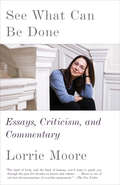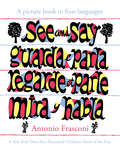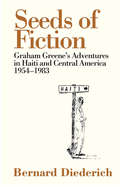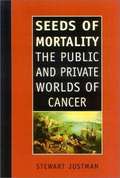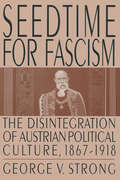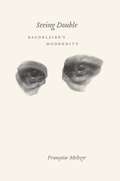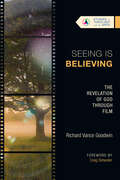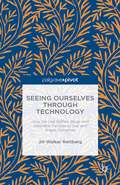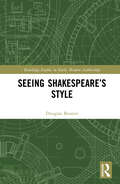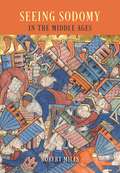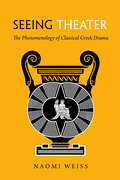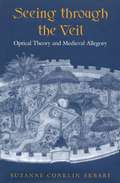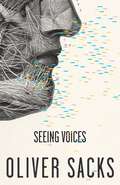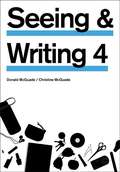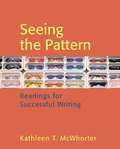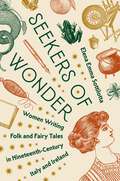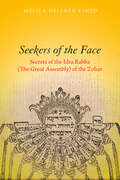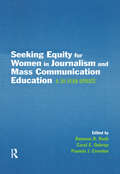- Table View
- List View
See What Can Be Done: Essays, Criticism, and Commentary
by Lorrie MooreA welcome surprise: more than fifty prose pieces, gathered together for the first time, by one of America's most revered and admired novelists and short-story writers, whose articles, essays and cultural commentary--appearing in The New York Review of Books, The New York Times Book Review, The New Yorker, The Atlantic, The Guardian, Harper's Magazine and elsewhere--have been parsing the political, artistic and media idiom for the last three decades.From Lorrie Moore's earliest reviews of novels by Margaret Atwood and Nora Ephron, to an essay on Ezra Edelman's 2016 O.J. Simpson documentary, and everything in between: this book features Moore on the writing of fiction (the work of V. S. Pritchett, Don DeLillo, Philip Roth, Joyce Carol Oates, Alice Munro, Stanley Elkin, Dawn Powell, Nicholson Baker et al.) . . . on the continuing unequal state of race in America . . . on the shock of the shocking GOP . . . on the dangers (and cruel truths) of celebrity marriages and love affairs . . . on the wilds of television (The Wire, Friday Night Lights, Into the Abyss, Girls, Homeland, True Detective, Making a Murderer) . . . on the (d)evolving environment . . . on terrorism, the historical imagination and the world's newest form of novelist . . . on the lesser (and larger) lives of biography and the midwifery between art and life (Anaïs Nin, Marilyn Monroe, John Cheever, Edna St. Vincent Millay, Eudora Welty, Bernard Malamud, among others) . . . and on the high art of being Helen Gurley Brown . . . and much, much more. "Fifty years from now, it may well turn out that the work of very few American writers has as much to say about what it means to be alive in our time as that of Lorrie Moore" (Harper's Magazine).
See What Can Be Done: Essays, Criticism, and Commentary
by Lorrie MooreA welcome surprise: more than fifty prose pieces, gathered together for the first time, by one of America's most revered and admired novelists and short-story writers, whose articles, essays, and cultural commentary--appearing in The New York Review of Books, The New York Times Book Review, The New Yorker, The Atlantic, The Guardian, Harper's Magazine, and elsewhere--have been parsing the political, artistic, and media idiom for the last three decades.From Lorrie Moore's earliest reviews of novels by Margaret Atwood and Nora Ephron, to an essay on Ezra Edelman's 2016 O.J. Simpson documentary, and in between: Moore on the writing of fiction (the work of V. S. Pritchett, Don DeLillo, Philip Roth, Joyce Carol Oates, Alice Munro, Stanley Elkin, Dawn Powell, Nicholson Baker, et al.) . . . on the continuing unequal state of race in America . . . on the shock of the shocking GOP . . . on the dangers (and cruel truths) of celebrity marriages and love affairs . . . on the wilds of television (The Wire, Friday Night Lights, Into the Abyss, Girls, Homeland, True Detective, Making a Murderer) . . . on the (d)evolving environment . . . on terrorism, the historical imagination, and the world's newest form of novelist . . . on the lesser (and larger) lives of biography and the midwifery between art and life (Anaïs Nin, Marilyn Monroe, John Cheever, Edna St. Vincent Millay, Eudora Welty, Bernard Malamud, among others) . . . and on the high art of being Helen Gurley Brown . . . and much, much more. "Fifty years from now, it may well turn out that the work of very few American writers has as much to say about what it means to be alive in our time as that of Lorrie Moore" (Harper's Magazine).
See and Say: A picture book in four languages
by Antonio Frasconi"In 1953, Time magazine called Antonio Frasconi America's foremost practitioner of the ancient art of the woodcut. Four decades later, Art Journal called him the best of his generation." ― The New York Times In this New York Times Best Book of the Year, internationally renowned artist Antonio Frasconi presents beautiful and brightly colored woodcuts depicting a variety of everyday items — a boat, Christmas tree, dog, train, birthday cake, and many other eye-catching objects. The word for each image is given in English (printed in black), Italian (blue), French (red), and Spanish (green), and accompanied by pronunciation guides. A page of common expressions such as "Good morning!" and "What time is it?" in each language appears at the end. For the very young, this is a delightful picture book; for older children, it offers useful illustrated language lessons. All will enjoy the whimsical images and accompanying words and phrases.
Seeds of Fiction: Graham Greene's Adventures in Haiti and Central America 1954–1983
by Pico Iyer Richard Greene Bernard DiederichA major new biography of Graham Greene with extensive new material; exclusive, never-before-seen photographs of Greene on his travels; and full family cooperationAn essential read for fans of literary biography, this book finally and fully illuminates a pivotal episode in Graham Greene's life and career in the kind of detail that will sate any fans of his work, but which also provides a fascinating glimpse into a writer's life. In 1965, Greene joined journalist Bernard Diederich in the Dominican Republic to embark on a tour of its border with Haiti, then ruled by "Papa Doc" Duvalier. They were accompanied by activist priest Jean-Claude Bajeux. Diederich had known Greene since the mid-1950s and had lived in Haiti for 14 years. He was a seasoned correspondent for the British and North American press and had reported many stories from the region, including Castro's triumph in Cuba and the death of the Dominican dictator, Trujillo. In 1963, he had been thrown out of Haiti and when Greene arrived was working from the Dominican Republic. The famous novelist was 61 and depressed, having struggled to finish A Burnt-Out Case, and was being plagued by religious doubt; Bajeux, meanwhile, had been informed that his family had been "disappeared" by Duvalier's henchmen. As this trio traveled along the border they met a number of rebels and other characters later fictionalized in Greene's most politically charged novel, The Comedians, published the following year. This book tells the story of how a series of extraordinary and often hair-raising journeys gave one of the greatest novelists of the 20th century new inspiration in his writing.
Seeds of Mortality: The Public and Private Worlds of Cancer
by Stewart JustmanUnless the patient's mind is made healthy, "whether the tumor shrinks or even goes into complete remission, genuine healing will not have occurred."
Seedtime for Fascism: Disintegration of Austrian Political Culture, 1867-1918
by George V. StrongThis study examines the political culture in Austria-Hungary in the latter half of the 19th century. It analyzes the centrifugal forces that arose from growing ethnic nationalism in the empire and that ultimately overpowered the centripetal forces which held the Austrian-Hungarian "state idea" together. The analysis is applied further to provide an historical explanation of analogous developments in post-1989 Europe.
Seeing Double: Baudelaire's Modernity
by Francoise MeltzerThe poet Charles Baudelaire (1821–1867) has been labeled the very icon of modernity, the scribe of the modern city, and an observer of an emerging capitalist culture. Seeing Double reconsiders this iconic literary figure and his fraught relationship with the nineteenth-century world by examining the way in which he viewed the increasing dominance of modern life. In doing so, it revises some of our most common assumptions about the unresolved tensions that emerged in Baudelaire’s writing during a time of political and social upheaval. Françoise Meltzer argues that Baudelaire did not simply describe the contradictions of modernity; instead, his work embodied and recorded them, leaving them unresolved and often less than comprehensible. Baudelaire’s penchant for looking simultaneously backward to an idealized past and forward to an anxious future, while suspending the tension between them, is part of what Meltzer calls his “double vision”—a way of seeing that produces encounters that are doomed to fail, poems that can’t advance, and communications that always seem to falter. In looking again at the poet and his work, Seeing Double helps to us to understand the prodigious transformations at stake in the writing of modern life.
Seeing Double: Baudelaire's Modernity
by Françoise MeltzerThe poet Charles Baudelaire (1821–1867) has been labeled the very icon of modernity, the scribe of the modern city, and an observer of an emerging capitalist culture. Seeing Double reconsiders this iconic literary figure and his fraught relationship with the nineteenth-century world by examining the way in which he viewed the increasing dominance of modern life. In doing so, it revises some of our most common assumptions about the unresolved tensions that emerged in Baudelaire’s writing during a time of political and social upheaval.Françoise Meltzer argues that Baudelaire did not simply describe the contradictions of modernity; instead, his work embodied and recorded them, leaving them unresolved and often less than comprehensible. Baudelaire’s penchant for looking simultaneously backward to an idealized past and forward to an anxious future, while suspending the tension between them, is part of what Meltzer calls his “double vision”—a way of seeing that produces encounters that are doomed to fail, poems that can’t advance, and communications that always seem to falter. In looking again at the poet and his work, Seeing Double helps to us to understand the prodigious transformations at stake in the writing of modern life.
Seeing Double: Intercultural Poetics in Ptolemaic Alexandria
by Susan A. StephensOffering a new and expanded understanding of Alexandrian poetry, Susan Stephens argues that poets such as Callimachus, Theocritus, and Apollonius proved instrumental in bridging the distance between the two distinct and at times diametrically opposed cultures under Ptolemaic rule.
Seeing Is Believing: The Revelation of God Through Film (Studies in Theology and the Arts Series)
by Richard Vance GoodwinHow might film reveal God?In its most basic form, film is a series of images displayed over time. Of course, film has developed greatly since the Lumière brothers by adding components such as sound, special effects, digital recording, and more to create an increasingly complex artistic medium. Historically, film studies has often focused on the narrative aspect of film as it seeks to tell a story. More recent studies, however, have turned attention to other elements of film, such as the musical score. Yet, film remains, in a sense, a series of images.In this study, the latest in IVP Academic's Studies in Theology and the Arts (STA) series, theologian Richard Goodwin considers how the images that constitute film might be a conduit of God's revelation. By considering works by Carl Theodor Dreyer, Stanley Kubrick, Paul Thomas Anderson, Robert Bresson, Martin Scorsese, Terrence Malick, and more, Goodwin argues that by inviting emotional responses, film images can be a medium of divine revelation.Blessed are those who have seen God... through film.
Seeing Ourselves Through Technology: How We Use Selfies, Blogs and Wearable Devices to See and Shape Ourselves
by Jill W. RettbergThis book is open access under a CC BY license. Selfies, blogs and lifelogging devices help us understand ourselves, building on long histories of written, visual and quantitative modes of self-representations. This book uses examples to explore the balance between using technology to see ourselves and allowing our machines to tell us who we are.
Seeing Shakespeare’s Style (Routledge Studies in Early Modern Authorship)
by Douglas BrusterSeeing Shakespeare’s Style offers new ways for readers to perceive Shakespeare and, by extension, literary texts generally. Organized as a series of studies of Shakespeare’s plays and poems, poetry and prose, it looks at the inner functioning of language and form in works from all phases of this writer’s career. Because the very concept of literary style has dropped out of so many of our conversations about writing, we need new ways to understand how words, phrases, speeches, and genres in literature work. Responding to this need, this book shows how visual representations of writing can lead to a deeper understanding of language’s textures and effects. Beginning with chapters that a beginning reader of Shakespeare can benefit from, its second half puts these tools to use in more in-depth examinations of Shakespeare’s language and style. Although focused on Shakespeare’s works, and the works of his contemporaries, this book provides tools for all readers of literature by defining style as material, graphic, and shaped by the various media in which all writers work.
Seeing Sodomy in the Middle Ages
by Robert MillsDuring the Middle Ages in Europe, some sexual and gendered behaviors were labeled "sodomitical” or evoked the use of ambiguous phrases such as the "unmentionable vice” or the "sin against nature. ” How, though, did these categories enter the field of vision? How do you know a sodomite when you see one? In Seeing Sodomy in the Middle Ages, Robert Mills explores the relationship between sodomy and motifs of vision and visibility in medieval culture, on the one hand, and those categories we today call gender and sexuality, on the other. Challenging the view that ideas about sexual and gender dissidence were too confused to congeal into a coherent form in the Middle Ages, Mills demonstrates that sodomy had a rich, multimedia presence in the period--and that a flexible approach to questions of terminology sheds new light on the many forms this presence took. Among the topics that Mills covers are depictions of the practices of sodomites in illuminated Bibles; motifs of gender transformation and sex change as envisioned by medieval artists and commentators on Ovid; sexual relations in religious houses and other enclosed spaces; and the applicability of modern categories such as "transgender,” "butch” and "femme,” or "sexual orientation” to medieval culture. Taking in a multitude of images, texts, and methodologies, this book will be of interest to all scholars, regardless of discipline, who engage with gender and sexuality in their work.
Seeing Stars Decoding Workbook 1: Who Is Fip?
by Nanci BellFor use with the Seeing Stars Program, this book contains decoding lists of words.
Seeing Suffering in Women's Literature of the Romantic Era
by Elizabeth A. DolanArguing that vision was the dominant mode for understanding suffering in the Romantic era, Elizabeth A. Dolan shows that Mary Wollstonecraft, Charlotte Smith, and Mary Shelley experimented with aesthetic and scientific visual methods in order to expose the social structures underlying suffering. Dolan's exploration of illness, healing, and social justice in the writings of these three authors depends on two major questions: How do women writers' innovations in literary form make visible previously unseen suffering? And, how do women authors portray embodied vision to claim literary authority? Dolan's research encompasses a wide range of primary sources in science and medicine, including nosology, health travel, botany, and ophthalmology, allowing her to map the resonances and disjunctions between medical theory and literature. This in turn points towards a revisioning of enduring themes in Romanticism such as the figure of the Romantic poet, the relationship between the mind and nature, sensibility and sympathy, solitude and sociability, landscape aesthetics, the reform novel, and Romantic-era science. Dolan's book is distinguished by its deep engagement with several disciplines and genres, making it a key text for understanding Romanticism, the history of medicine, and the position of the woman writer during the period.
Seeing Theater: The Phenomenology of Classical Greek Drama
by Naomi WeissThis is the first book to approach the visuality of ancient Greek drama through the lens of theater phenomenology. Gathering evidence from tragedy, comedy, satyr play, and vase painting, Naomi Weiss argues that, from its very beginnings, Greek theater in the fifth century BCE was understood as a complex interplay of actuality and virtuality. Classical drama frequently exposes and interrogates potential viewing experiences within the theatron—literally, "the place for seeing." Weiss shows how, in so doing, it demands distinctive modes of engagement from its audiences. Examining plays and pottery with attention to the instability and ambiguity inherent in visual perception, Seeing Theater provides an entirely new model for understanding this ancient art form.
Seeing Things
by Alan AckermanA technological revolution has changed the way we see things. The storytelling media employed by Pixar Animation Studios, Samuel Beckett, and William Shakespeare differ greatly, yet these creators share a collective fascination with the nebulous boundary between material objects and our imaginative selves. How do the acts of seeing and believing remain linked? Alan Ackerman charts the dynamic history of interactions between showing and knowing in Seeing Things, a richly interdisciplinary study which illuminates changing modes of perception and modern representational media.Seeing Things demonstrates that the airy nothings of A Midsummer Night's Dream, the Ghost in Hamlet, and soulless bodies in Beckett's media experiments, alongside Toy Story's digitally animated toys, all serve to illustrate the modern problem of visualizing, as Hamlet put it, 'that within which passes show.' Ackerman carefully analyses such ghostly appearances and disappearances across cultural forms and contexts from the early modern period to the present, investigating the tension between our distrust of shadows and our abiding desire to believe in invisible realities. Seeing Things provides a fresh and surprising cultural history through theatrical, verbal, pictorial, and cinematic representations.
Seeing Through the Veil
by Suzanne Conklin AkbariDuring the later Middle Ages, new optical theories were introduced that located the power of sight not in the seeing subject, but in the passive object of vision. This shift had a powerful impact not only on medieval science but also on theories of knowledge, and this changing relationship of vision and knowledge was a crucial element in late medieval religious devotion. In Seeing through the Veil, Suzanne Conklin Akbari examines several late medieval allegories in the context of contemporary paradigm shifts in scientific and philosophical theories of vision.After a survey on the genre of allegory and an overview of medieval optical theories, Akbari delves into more detailed studies of several medieval literary works, including the Roman de la Rose, Dante's Vita Nuova, Convivio, and Commedia, and Chaucer's dream visions and Canterbury Tales. The final chapter, 'Division and Darkness,' centres on the legacy of allegory in the fifteenth century. Offering a new interdisciplinary, synthetic approach to late medieval intellectual history and to major works within the medieval literary canon, Seeing through the Veil will be an essential resource to the study of medieval literature and culture, as well as philosophy, history of art, and history of science.
Seeing Voices: A Journey into the World of the Deaf
by Oliver SacksSign language is, in the hands of its masters, a most beautiful and expressive language.
Seeing and Writing (4th edition)
by Donald Mcquade Christine McquadeSeeing & Writing 4, with a new look, new features, and new essays and images, continues to lead the way as a visual, flexible, and above all, inspiring tool for the composition classroom.
Seeing the Pattern: Readings for Successful Writing
by Kathleen T. McwhorterSeeing the Pattern provides abundant help and support for inexperienced readers and writers through the application of tools and techniques that the author developed over more than thirty years of teaching.
Seekers of Wonder: Women Writing Folk and Fairy Tales in Nineteenth-Century Italy and Ireland
by Elena Emma SottilottaWomen&’s cultural and political engagement with oral tales and traditions in European peripheries With Seekers of Wonder, Elena Sottilotta offers the first comparative study of women&’s manifold roles in the collection of Italian and Irish folklore and fairy tales between 1870 and 1920. Sottilotta views the often-overlooked work of these women from an interdisciplinary perspective, considering both the politics and poetics of seeking wonder. In so doing, she centers women&’s influence on the preservation and dissemination of oral traditions, bringing work that was once relegated to the margins into dialogue with work long regarded as canonical.After mapping sidelined, marginalized, and forgotten women folklorists, Sottilotta narrows the focus onto four writers and collectors who were inspired by Italian and Irish insular contexts: Laura Gonzenbach, who collected Sicilian wonder tales; Grazia Deledda, who wrote Sardinian ethnographic sketches, legends, and fairy tales; Jane Wilde, who published anthologies of Irish folklore; and Augusta Gregory, who collected traditional narratives in the west of Ireland. Situated within an ongoing process of rediscovery of lesser-known collectors, tellers, and tales in the European tradition, Sottilotta relocates these figures within a broader transcultural framework.Throughout, Sottilotta emphasizes the role of women as crucial intermediaries between different cultural groups—in particular, between the world of the &“folk&” and the world of scholarly folklore studies. Unearthing rare archival material and reading these writings from the perspective of gender, Sottilotta sheds light on the identity dynamics that animated the cultural phenomenon of collecting folk and fairy tales in this era.
Seekers of the Face: Secrets of the Idra Rabba (The Great Assembly) of the Zohar (Studies in Jewish Mysticism)
by Melila Hellner-EshedA magisterial, modern reading of the deepest mysteries in the Kabbalistic tradition. Seekers of the Face opens the profound treasure house at the heart of Judaism's most important mystical work: the Idra Rabba (Great Gathering) of the Zohar. This is the story of the Great Assembly of mystics called to order by the master teacher and hero of the Zohar, Rabbi Shim'on bar Yochai, to align the divine faces and to heal Jewish religion. The Idra Rabba demands a radical expansion of the religious worldview, as it reveals God's faces and bodies in daring, anthropomorphic language. For the first time, Melila Hellner-Eshed makes this challenging, esoteric masterpiece meaningful for everyday readers. Hellner-Eshed expertly unpacks the Idra Rabba's rich grounding in tradition, its probing of hidden layers of consciousness and the psyche, and its striking, sacred images of the divine face. Leading readers of the Zohar on a transformative adventure in mystical experience, Seekers of the Face allows us to hear anew the Idra Rabba's bold call to heal and align the living faces of God.
Seeking Equity for Women in Journalism and Mass Communication Education: A 30-year Update (Routledge Communication Series)
by Ramona R. Rush, Carol E. Oukrop and Pamela J. CreedonThis volume concentrates on the study and efforts of women and minority men to gain respect and parity in journalism and mass communication, and focuses on trends over the past three decades. Contributions to the volume provide a history of the equity efforts and offer updates on equity in the academy and in the professions. Theoretical and international perspectives on equity are also included, as are the concerns about equity from the new generations now coming into the profession. This anthology serves as a benchmark of women's current status in journalism and mass communication and provides a call to action for the future. As such, it is required reading for all concerned with establishing equity throughout the discipline.
